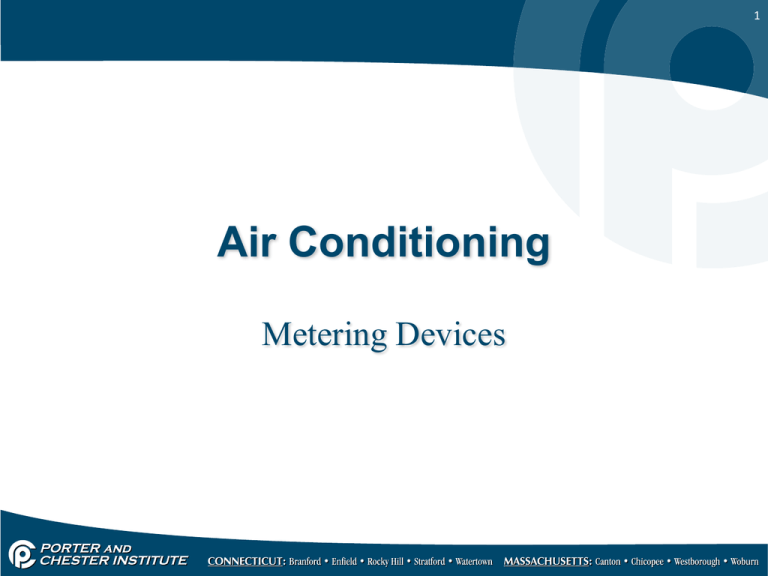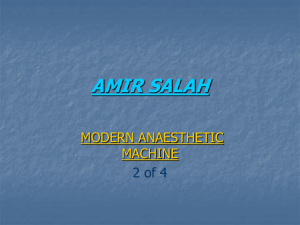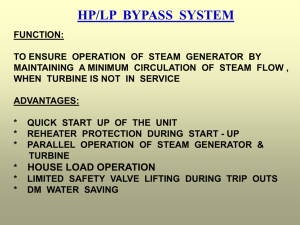HVACR415_L13_MeteringDevices
advertisement

1 Air Conditioning Metering Devices 2 Metering Devices • Used in an A/C system to change the pressure of the refrigerant. • Is placed between the liquid line and the evaporator. • Reduces the high pressure in the liquid line to low pressure in the evaporator. 3 Metering Devices • Controls the flow of refrigerant to the evaporator coil. • Maintains the correct superheat. • Creates the flash gas at the start of the evaporator coil. 4 Metering Devices • Types – Capillary Tube – Thermostatic Expansion Valve – Automatic Expansion Valve – Fixed Orifice (AC Only) – Electronic Expansion Valve 5 Capillary Tube • Non-mechanical • Provides a constant flow (or feed) of refrigerant. • Non-Adjustable • Typical size: .031” diameter (very small) as in 1/32 inch. 6 Capillary Tube • Sometimes used to form a heat exchanger by attaching it (by solder) to the suction line or by wrapping it around the suction line. • The best way to cut a capillary tube is to gently notch it with a file and then snap it at that point. Do not crush the tube. 7 Capillary Tube • Installing a cap tube is done by crimp connections because of its diameter. • When replacing a cap tube cut the same length of new tubing as the original one in the system. Be sure it is the same diameter. 8 Capillary Tube 9 Capillary Tubes The capillary tube determines the amount of refrigerant that passes through based on the diameter and the length. The combination of the diameter and the length will cause a pressure drop. The longer the tube, the smaller the hole to larger pressure drop. 10 Capillary Tubes 11 Capillary Tubes 12 Thermostatic Expansion Valve • The TXV is a temperature actuated metering device. • The valves mechanisms respond to load variations. • The purpose is to keep the superheat of the evaporator coil constant. 13 Thermostatic Expansion Valve • The bulb is attached to the suction line after the evaporator coil (evaporator Outlet). The bulb must be insulated and mounted on a horizontal section of line. • The bulb can NOT be installed at the bottom of the line. 14 Thermostatic Expansion Valve 15 Thermostatic Expansion Valve 16 Thermostatic Expansion Valve • The sensing bulb senses the temperature in the suction line and the force created by the gas in the bulb will open or close the valve. • The fluid or gas inside the sensing bulb is called the “charge”. 17 Thermostatic Expansion Valve • TXV’s use four types of charges: – Liquid charge – has a refrigerant that has the same pressure/temp relationship as the system. – Cross liquid charge – has a fluid that does not follow the temperature/pressure relationship of the system. Low temp applications. – Vapor charge – Cross vapor charge 18 Thermostatic Expansion Valve • TXV’s use four types of charges: – Vapor charge – sometimes called critically charged bulbs. Has a small amount of liquid, mostly vapor. Also used for Maximum Operating Pressure bulbs. Can only exert so much force on the diaphragm. – Cross vapor charge – same as vapor but different temp/pressure relationship than what is in system. 19 Thermostatic Expansion Valve Temperature pressure of crossed charged bulb. 20 Thermostatic Expansion Valve • Inside the valve body there is a needle and a seat that is usually made of a hard metal, such as steel. The movement of these two parts create the valve action. • The seat is stationary and the valve moves. 21 Thermostatic Expansion Valve 22 Thermostatic Expansion Valve 23 Thermostatic Expansion Valve • The TXV is adjustable. – Turning the adjustment counter clockwise sends more liquid into the coil which reduces the superheat. – Turning the adjustment clockwise chokes off the flow of refrigerant and increases the superheat. – Do any adjustments VERY slowly and give the system time to respond. 24 Thermostatic Expansion Valve The TXV starts in an equalized setting with 10 degree superheat. 25 Thermostatic Expansion Valve • As load conditions change and heat is added to the conditioned space: – The sensing bulb starts warming up. – The valve opens. – Allows more liquid into the evaporator. – Lowers superheat. 26 Thermostatic Expansion Valve The load on the evaporator goes up as the load increases and the valve opens increasing the flow of refrigerant into the coil. 27 Thermostatic Expansion Valve • As the demand for cooling decreases: – The bulb cools off. – Takes pressure off of the diaphragm. – Closes the valve. – Decreases the flow of refrigerant. – Raises the superheat. 28 Thermostatic Expansion Valve The load requirement drops and the evaporator cools down the valve starts to close and decreases the flow of refrigerant to the coil. 29 Thermostatic Expansion Valve • With newer evaporators there is a pressure drop from the metering device to the suction line. • If the pressure drop exceeds 2.5 psi a TXV with an external equalizer line should be used. • The external equalizer is used to compensate for the pressure drop from the inlet to the outlet of the evaporator. 30 Thermostatic Expansion Valve • Distributors are the “octopus” looking things following the expansion valve on larger multiple pass evaporators. • The distributors distribute the refrigerant through the multiple passes. 31 Thermostatic Expansion Valve • The rate of flow of liquid through the TXV is directly proportional to the load conditions. 32 Thermostatic Expansion Valve • The forces that control a TXV are: – Sensing bulb – This is the downward force that will open the valve. – Evaporator pressure – Creates an upward force that will close the valve along with the spring pressure. – Spring pressure – creates an upwards force on the needle and helps close the TXV. This is the only adjustable part. 33 Thermostatic Expansion Valve • The TXV is designed to work at equilibrium. 34 Thermostatic Expansion Valve • There are three factors that affect the capacity of the TXV: – Evaporator Temperature – Pressure drop across the valve – Temperature of liquid entering the valve. 35 Thermostatic Expansion Valve • Adjustments – By adjusting the spring pressure the superheat can be changed. • TXV’s can be internally or externally equalized. – Internal has two lines, one is the liquid inlet and the other is the evaporator port outlet. 36 Thermostatic Expansion Valve – Externally equalized has three lines, the liquid line, the evaporator outlet line, and the equalizer line. • With externally equalized TXV’s the bulb must be mounted between the evaporator coil outlet and the equalizer line. 37 Thermostatic Expansion Valve • The equalizer line must be as close to the compressor side as possible to ensure that 100% vapor is entering the ¼” line. Any liquid will cause improper TXV operation. • External equalizers are used on large evaporator coils where there is a pressure drop. 38 Thermostatic Expansion Valve 39 Thermostatic Expansion Valve • The equalizer line will be connected onto the suction line to assist the evaporator pressure (upward force) for proper operation. • The sensing bulb must be between the equalizing line and the evaporator so no liquid can get to it. 40 Thermostatic Expansion Valve • Externally equalized TXV’s must be used when: – Pressure drop on a air-conditioning system exceeds 3 psig. – Pressure drop on a commercial refrigeration system exceeds 2psig. – Pressure drop on a low temperature system exceeds 1psig. 41 Thermostatic Expansion Valve • Superheat Adjustments – TXV’s are adjusted at the factory. – When an improper superheat is suspected first check the manufacturers recommendations. – Front setting the valve (turning it in) will starve the coil or increase the superheat. By front seating we are turning clockwise. 42 Thermostatic Expansion Valve • Back seating the stem of the valve (turning it out) will flood the coil with additional refrigerant and will lower the superheat. 43 Thermostatic Expansion Valve • Superheat Measurement – The best place to get the temperature reading is at the sensing bulb of the TXV. – If you can not access this point and the compressor has a long run to it add 2psi to your gauge reading. – Convert the compound (low side) gauge to temperature. 44 Thermostatic Expansion Valve – Subtract the saturation temperature (boiling point temperature from your gauges) from the suction line temperature (near sensing bulb). – This is the superheat. • It is VERY important to realize that it takes a few minutes for superheats to change. 45 Thermostatic Expansion Valve • Sensing bulb location – When mounting the bulb make sure the suction line area is clean for good heat transfer. If it is not – sand it. – Should be secured tightly (at least by two straps). – Should be insulated. – Should not be mounted under the pipe as liquid refrigerant and oil can sit on it and cause incorrect readings. 46 Thermostatic Expansion Valve 47 Thermostatic Expansion Valve – Some TXV’s are considered maximum operating pressure TXV’s. – MOP TXV’s place a limit on the evaporator’s pressure to prevent the compressor from overheating. – They do this by not opening fully under heavy load conditions. 48 Thermostatic Expansion Valve • Dual Port TXV’s – Have two needles and seats that are in series. – Are used in cases where a single TXV does not fit the specifications. – Example of this is a beer cooler where you may need a large amount of cooling for a short time when a new shipment comes in. Then the cooler cools off and you need less of a load. 49 Example of a Dual Port TXV. 50 Thermostatic Expansion Valve • Balanced Port TXV’s – Are designed to operate in low ambient conditions when the head pressure (liquid) drops. – The liquid pressure that opens the TXV is canceled out across a large needle. – This TXV can also handle small amounts of vapor and flash gas. 51 Balanced Port TXV’s 52 Automatic Expansion Valve • Also known as an AEV or a constant pressure valve. • The AEV does the same thing as a capillary tube does – it acts like a water valve. • It is not seen as much as the TXV. 53 Automatic Expansion Valve • The AEV responds to a load change exactly opposite from the TXV. • As the load increases the AEV will start to starve the evaporator, thus maintaining pressure and boiling point. • As the load drops the AEV will begin to open and allow the pressure to remain constant as well as boiling point. 54 Automatic Expansion Valve 55 Automatic Expansion Valve • The force that operates an AEV is the evaporator pressure. This is the upward force on the bottom of the diaphragm that tends to close the valve • When you front seat the valve on the AEV (clockwise) you are opening the valve which puts more liquid into the coil and lowers the superheat. 56 Automatic Expansion Valve • When you backseat the valve on the AEV (counter clockwise) you are starving the coil which raises the superheat. • Atmospheric and adjustable spring pressure exert a downward force that will open the valve. 57 Automatic Expansion Valve • AEV’s are designed to maintain a constant pressure in the evaporator. • When checking AEV’s you rarely have a pressure port right next to the evaporator and need to add 2psi to your readings to account for pressure drop. 58 Automatic Expansion Valve • Systems with AEV’s and most systems with TXV’s should have a receiver to ensure a proper refrigerant flow to the valve. • The systems with a capillary tube will never (or rarely) have a receiver. • The receiver is a type of storage tank to hold extra refrigerant. 59 Automatic Expansion Valve 60 Solid State Expansion Valve • Solid state expansion valves replace the sensing bulb with a thermistor and the spring/diaphragm combination with a heat motor. • The thermistor varies it’s resistance based on temperature. 61 Solid State Expansion Valve • As this resistance varies the voltage that is sent to the heat motor varies, thus opening and closing the valve. • The thermistor is inserted INTO the vapor stream at the outlet of the evaporator. • It will sense liquid in the line and CLOSE the metering device. 62 Solid State Expansion Valve 63 Solid State Expansion Valve 64 Step Motor Expansion Valve • Also known as an Electronic Expansion Valve. • Uses a small motor to control the expansion valve’s port. • The step motor rotates a fraction of a degree for each signal sent by a controller. 65 Step Motor Expansion Valve • The controller remembers how many steps taken and can return to a prior step at any time. • The controller includes a microprocessor that is programmed with an algorithm that controls the motor based on a feedback loop with a thermistor. 66 Step Motor Expansion Valve 67 Step Motor Expansion Valve 68 Step Motor Expansion Valve • The communication between the microprocessor (computer), the step motor (valve), the algorithm, and the sensor is considered a feedback loop. 69 Step Motor Expansion Valve 70 Step Motor Expansion Valve 71 Step Motor Expansion Valve 72 Step Motor Expansion Valve 73






